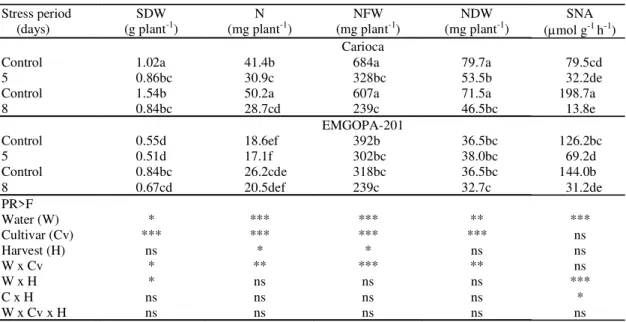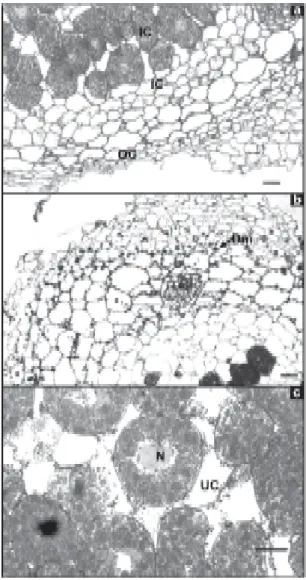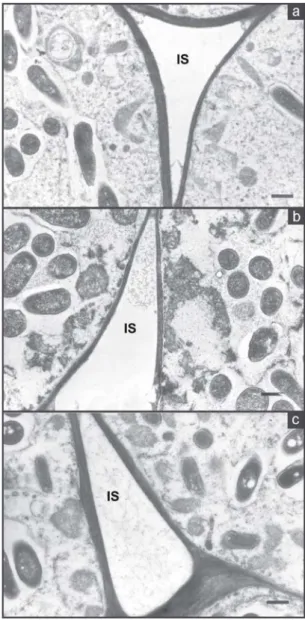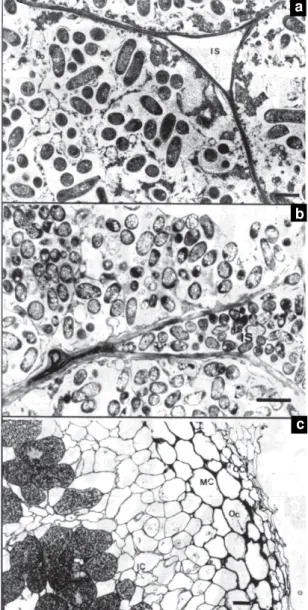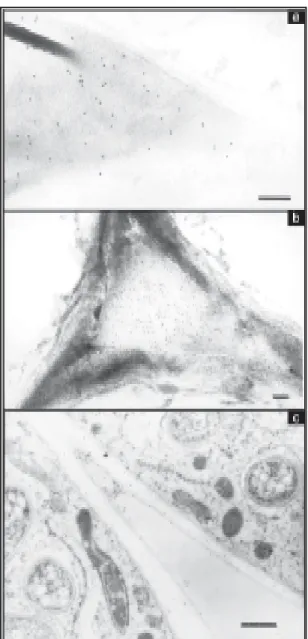Effect of water stress on nitrogen fixation and nodule structure
of common bean
(1)Maria Lucrecia Gerosa Ramos(2), Richard Parsons(3), Janet Irene Sprent(3) and Euan Kelvin James(3)
Abstract – The aim of this work was to investigate the effect of water stress on N2 fixation and nodule
structure of two common bean (Phaseolus vulgaris L.) cultivars Carioca and EMGOPA-201. Plants were harvested after five and eight days of water stress. Carioca had lower nodule dry weight on both water stress periods; shoot dry weight was lower at five days water stress and did not differ from control after eight days stress. Both cultivars had lower nitrogenase activity than control after five and eight days water stress. For both cultivars, after eight days stress bacteroid membranes were damaged. Carioca presented more pronounced damage to infected tissue, with host cell vacuolation and loss of the peribacteroid membrane at five days after stress; at eight days after stress, there was degradation of cytoplasm host cells and senescence of bacteroids, with their release into intercellular spaces. Intensity of immunogold-labeling of intercellular cortical glycoprotein with the monoclonal antibodies MAC 236/ 265 was different for both cultivars.
Index terms: Phaseolus vulgaris, nitrogenase, leaf water potential, nodulation.
Efeito do estresse hídrico na fixação biológica de nitrogênio e estrutura de nódulos de feijão
Resumo – O objetivo deste trabalho foi investigar o efeito do estresse hídrico na fixação biológica do N2
e na estrutura dos nódulos de feijão (Phaseolus vulgaris L.), nas cultivares Carioca e EMGOPA-201. As plantas foram colhidas após cinco e oito dias de estresse hídrico. A cultivar Carioca apresentou menor peso seco de nódulos que o controle (plantas irrigadas). O peso da parte aérea seca da cultivar Carioca foi menor aos cinco dias de estresse hídrico e não diferiu do controle, após oito dias de estresse. As duas cultivares tiveram menor atividade da nitrogenase após cinco e oito dias de estresse hídrico e apresentaram danos na membrana peribacteróide após oito dias de estresse. A cultivar Carioca foi mais afetada do que a EMGOPA-201, com vacuolação das células e perda da membrana peribacteróide após cinco dias de estresse; aos oito dias, houve degradação das células do citoplasma, senescência e liberação dos bacteróides nos espaços intercelulares. A intensidade de glicoproteínas nos espaços intercelulares do córtex, marcada com os anticorpos MAC 236/265, foi diferente nas duas cultivares de feijão.
Termos para indexação: Phaseolus vulgaris, nitrogenase, potencial de água na folha, nodulação.
(1)Accepted for publication on July 19, 2002.
(2)Universidade de Brasília, Fac. de Agronomia e Medicina
Veterinária, Caixa Postal 04508, CEP 70910-970 Brasília, DF. E-mail: lucrecia@unb.br
(3)University of Dundee, Dundee, DD1 4HN, UK.
Introduction
Common bean (
Phaseolus vulgaris
L.) is the major
source of protein in Latin America. This legume can
associate with
Rhizobium
and fix atmospheric N,
leading to lower production costs and decreasing
problems of pollution caused by N fertilizers, such
as nitrate. However, there are several factors affecting
its performance in tropical conditions, such as high
temperatures (Ferrari et al., 1967), low soil pH (Ramos
& Boddey, 1987), Al toxicity (Franco & Munns, 1982)
and water availability (Ramos et al.,
1999).
Factors affecting plant development can alter the
formation and growth of nodules. A decrease in soil
water potential can markedly affect root hair
(Worral & Roughley, 1976) and retard nodule growth
(Gallacher & Sprent, 1978) and N
2fixation (Ramos
et al., 1999). Once nodules are formed, water stress
can also lead to morphological and physiological
alterations. Guerin et al. (1990) observed in
Vicia faba
alterations in cell shape in the cortex where cells were
densely packed, leading to reduction in air spaces
and subsequent reduction of O
2diffusion barrier to
Although there are several publications showing
changes in nodule structure in plants under salt stress
(Serraj et al., 1995), there is little information about
the effects of drought on legume nodule structure.
Common bean cultivars vary in tolerance to water
stress. Out of seven cultivars studied by Pimentel
et al. (1990), two were tolerant to water stress, and
had the same productivity with or without stress.
The aim of this work was to investigate the effects
of water stress on nitrogen fixation and nodule
structure of two common bean cultivars.
Material and Methods
Seeds of cultivars EMGOPA-201 and Carioca of common bean (Phaseolus vulgaris L.) were surface sterilized in 80% ethanol for 30 seconds, 5% sodium hypochlorite for two minutes and washed ten times in sterilized distilled water. Seeds were pre-germinated in Petri dishes with wet filter paper for two days. After this period the seeds were transferred to pots with a mixture of washed vermiculite and perlite (1:1 v/v) and inoculated with 1 cm3
of a mixture of two effective strains of Rhizobium (Rhizobium leguminosarum bv. phaseoli - strain BR 353 and Rhizobium tropici - strain BR 322). These strains are efficient on N2 fixation.
The experiment was arranged in a four randomized blocks design and a factorial scheme 2x2x2, with two cultivars, two levels of water stress and two controls for each stress.
Plants were grown in a mixture of sand and vermiculite (1:1) in a growth chamber with 14-hour photoperiod, which emitted a quantum irradiance of 700 µmol photons m-2 s-1,
day/night temperatures of 24oC and 16oC, respectively,
and relative humidity of approximately 50%. The macronutrient solution composition (Summerfield et al., 1977) was in mg dm-3: CaSO
4, 500; MgSO4.7H2O, 275;
K2HPO4, 175; NaFeEDTA, 41; K2SO4, 169. The
micronutrient solution was in g dm-3: KCl, 13.5; H 3BO3,
15; MnSO4.H2O, 8.5; ZnSO4.7H2O, 1.35; CuSO4.5H2O,
1.2 and MoO3, 11.18. A stock nutrient solution was added
at 0.2 cm3 dm-3.
Plants were kept at field capacity for 24 days before the stress treatments were started. Water was withheld from half of the plants which were harvested after five and eight days of water stress. There was a parallel control watered for each harvest. After being harvested, plants were dried at 65oC and grounded for determination of N
concentration, using a Analyzer (Model 1106). Leaf wa-ter potential (LWP) was measured in the youngest fully
most expanded leaf, using a pressure bomb (Scholander et al., 1965). Relative water content was measured in one leaflet just below the youngest expanded leaf. The relative water content per cent (RWC) was determined through the following equation:
RWC = (FW-DW)/(SW-DW)x100
where FW: fresh weight; DW: dry weight; SW: shoot weight. Acetylene reduction was measured in an open flow system, following the procedure of Minchin et al. (1983). Fresh nodules were excised from the root, cut in half and fixed in 2.5% glutaraldehyde in 50 mmol dm-3
potas-sium phosphate buffer, pH 6.8, at 4oC. Specimens were
rinsed in the same buffer and half of them were postfixed for two hours in 0.2% osmium tetroxide. After washing with the same buffer, nodules were dehydrated in an etha-nol series and placed in LR White Acrylic resin on a speci-men rotator at 120 rpm for seven days at 40oC. Specimens
were transferred to an oven at 60oC to polymerize the
resin.
Sections were cut on a Reichert Om V3 microtome (1 µm), stained with 33 mmol dm-3 toluidine blue in
162 mmol dm-3 sodium tetraborate and examined using an
light microscope.
From nodule pieces (1 mm) treated with osmium, ul-trathin sections were cut with a glass or diamond knife on a Reichert Om V3 microtome and collected on copper grids. Sections were stained with uranyl acetate for 30 min, then transferred to drops of lead citrate for ten minutes. They were examined using a 1200 EX transmission elec-tron microscope.
Thin sections (90 nm) were processed according to Bradley et al. (1988) and James (1990). They were col-lected on pyroxylin, carbon-coated nickel grids and incu-bated for one hour at room temperature on drops of block-ing buffer, consistblock-ing of bovine serum albumin in Tris-HCl, pH 7.5; 0.9% (w/v) sodium chloride; 0.5 mg cm-3
poly-ethylene glycol - 20kD; 0.02% (w/v) sodium azide to pre-vent non specific binding on the antibodies. The grids were washed in distilled water and then transferred to 50 mm3
drops of primary antibody (MAC 236, MAC 265) di-luted 1:100 in blocking buffer and incubated at 4oC for
8-16 hours. The grids were washed with distilled water and placed on 25 mm3 drops of the secondary antibody
antibodies MAC 236 and MAC 265 as a control for non-specific labeling (Vandenbosch et al., 1994).
Results and Discussion
Carioca shoots grew almost twice as much as
those of EMGOPA-201. Watered plants at the
sec-ond harvest (control) showed higher N
accumula-tion and nitrogenase activity than those from the
first harvest (control), suggesting that plants were
fixing and accumulating nitrogen (Table 1). Carioca
shoot dry weight decreased 16% after five days
with-out water. After eight days, there was still a trend of
lower values for shoot dry weight, but they did not
differ statistically from the control. Shoot dry weight
of EMGOPA-201 was not affected by stress.
Carioca shoots had lower N uptake after five and
eight days of water stress and decreases were 25%
and 40%, compared to respective controls (Table 1).
For EMGOPA-201, there was no significant
differ-ence between the controls and stress levels for this
parameter.
In general, EMGOPA-201 had lower nodule fresh
and dry weights than Carioca (Table 1). Although
nodule fresh weight was similar in Carioca watered
on both harvests, nitrogenase activity was higher at
eight days, suggesting an improvement in nitrogen
fixation. Nodule fresh weight was lower on both
lev-els of stress for Carioca, with decreases of 52% and
60% for five and eight day stresses, respectively
(Table 1). Saito et al. (1984) also observed a sharp
decrease in nodule fresh weight for cultivar Carioca
under two levels of water stress. Nodule fresh weight
in EMGOPA-201 was not affected by stress
treat-ment. Nodule dry weight decreased by 33% and 35%
in relation to the respective controls, for cultivar
Carioca and did not change for EMGOPA-201 at any
level of stress (Table 1).
Specific nitrogenase activity was always lower
under water stress on both cultivars (Table 1).
Mois-ture greatly affects nitrogenase activity in legumes
and in situations of extreme stress, nitrogenase
ac-tivity ceases (Guerin et al., 1990). Even a mild stress
(drop in leaf water potential of -0.4 MPa) can
signifi-cantly reduce nitrogenase activity in legumes (Rao &
Venkateswarlu, 1987). A decrease in nitrogenase
ac-tivity leads to low production of ammonia and to a
decrease in ammonia-assimilating enzymes under
water stress (Kaur et al., 1985).
Table 1. Shoot dry weight (SDW), total N on shoot (N), nodule fresh weight (NFW), nodule dry weight (NDW) and specific nitrogenase activity (SNA) of two common bean cultivars under two water stress periods(1).
Stress period SDW N NFW NDW SNA
(days) (g plant-1) (mg plant-1) (mg plant-1) (mg plant-1)
(µmol g-1 h-1)
Carioca
Control 1.02a 41.4b 684a 79.7a 79.5cd
5 0.86bc 30.9c 328bc 53.5b 32.2de
Control 1.54b 50.2a 607a 71.5a 198.7a
8 0.84bc 28.7cd 239c 46.5bc 13.8e
EMGOPA-201
Control 0.55d 18.6ef 392b 36.5bc 126.2bc
5 0.51d 17.1f 302bc 38.0bc 69.2d
Control 0.84bc 26.2cde 318bc 36.5bc 144.0b
8 0.67cd 20.5def 239c 32.7c 31.2de
PR>F
Water (W) * *** *** ** ***
Cultivar (Cv) *** *** *** *** ns
Harvest (H) ns * * ns ns
W x Cv * ** *** ** ns
W x H * ns ns ns ***
C x H ns ns ns ns *
W x Cv x H ns ns ns ns ns
(1)Numbers followed by the same letter in each column do not differ statistically by the Duncan’s test at 5% probability level; data are means of four
Stress period (days) LWP (Bar) RWC Carioca
Control -4.95d 91.83a
5 -8.85b 86.66b
Control -4.47d 94.02a
8 -10.55a 81.33c
EMGOPA-201
Control -4.65d 96.76a
5 -6.32c 93.59a
Control -4.27d 94.15a
8 -7.77b 92.55a
Leaf water potential was similar for all controls on
both cultivars, however during the period of stress,
cultivar Carioca showed lower levels than
EMGOPA-201 on both levels of water stress (five
and eight days) (Table 2).
Relative water content in leaves was similar for
EMGOPA-201 in all treatments but differed
statisti-cally from the controls for Carioca (Table 2). Although
the correlation between LWP and relative water
con-tent had a low R
2(0.62), RWC results suggest that
stress effect was higher in Carioca than in
EMGOPA-201 (Table 2). As a consequence, Carioca
was more affected at eight days than EMGOPA-201,
with a sharp decrease in nodule fresh weight (loss of
60%) and very low levels of nitrogenase activity.
Shoot and nodule dry weights of EMGOPA-201 were
not affected by stress, but nitrogenase activity
de-creased sharply, mainly at eight days of water stress.
Root nodules from both cultivars which were
watered had several layers of cells in the lenticels
(Figure 1a). The outer cortex had approximately two
layers of large and compacted cells with deposits of
dark-staining material in the intercellular spaces. Cells
were progressively smaller from the middle and inner
cortex; there were 1-2 layers of small and
interlock-ing cells, which are analogous to the boundary layer,
described by Parsons & Day (1990) for soybean. Few
electron-transparent inclusions, presumably
po-ly-
β
-hydroxybutyrate (PHB), could be seen in the
bacteroids (Figure 2a). There were numerous
inter-cellular spaces in the infected tissue and most
ap-peared not to be occluded (Figure 3a).
Consistent with the growth data (Table 1), the
structure of nodules from cultivar Carioca was more
Table 2. Leaf water potential (LWP) and relative water content (RWC) of two common bean cultivars, under water stress(1).
(1)Numbers followed by the same letter in each column do not differ
statistically by Duncan’s test at 5% of probability; data are means of four replicates.
and few inclusions of PHB are visible within the
bacteroids (Figures 3b and 4a).
For EMGOPA-201, at eight days of water stress,
fewer lenticels were found and a dark-staining
mate-rial was not observed in any part of the cortex,
sug-gesting that the material was metabolized by the cells
Figure 2. Transmission electron micrograph, showing inclusions of PHB in a nodule from cultivar EMGOPA-201 (a) watered, with peribacteroid membrane (PBM), PHB granules (Po) and from cultivar Carioca (b), after five days of water stress, showing rupture of peribacteroid membrane, bacteroid (B) and PHB granules (Po). Bar = 1 µm.
affected by water stress than EMGOPA-201. For
EMGOPA-201, at five days of water stress, in the
lenticels, outer cortex, pericycle cells and vascular
bundles, a dark staining material can be seen within
the cells (Figure 1b). James et al. (1993) and Serraj
et al. (1995) also found a dark-staining material in the
cortex of soybean under salt stress. In the middle
cortex, cell walls appear convoluted (Figure 1b).
Nu-clei can be seen in the infected cells (Figure 1c).
How-ever, peribacteroid membranes appear ruptured
(Figure 3b). More inclusions of PHB are found within
the bacteroid for Carioca (Figure 2b). For cultivar
EMGOPA-201, some material was released into the
intercellular spaces of the infected tissue, but
bacteroids were not found in the spaces (Figure 3b)
Figure 4. Transmission electron micrograph showing in-clusions of PBH and a rupture of peribacteroid membrane (PBM) of a nodule from cultivar EMGOPA-201 at five days of water stress (a); cultivar Carioca after eight days of water stress (b), showing bacteroids free in the infected cells, without any apparent membrane and intercellular spaces (IS) filled with bacteroids and cultivar EMGOPA-201 after eight days of water stress (c), show-ing outer cortex (OC), cytoplasmic degradation in the in-ner (IC) and middle cortex (MC). Bar = 1 mm (a), Bar = 2 mm (b), Bar = 25 mm (c).
(Figure 4c). Cells from all parts of the cortex appeared
flaccid and tightly compacted, with intercellular
spaces occluded. Compared with other treatments,
more inclusions of PHB are found for EMGOPA-201
(Figure 4a) and for Carioca (Figure 4b). Peribacteroid
membranes were ruptured and a release of material
was observed in the intercellular spaces of Carioca
which are filled with bacteria (Figure 4b). Water
stress is not the only kind of stress which can lead to
a release of bacteroids in the intercellular spaces.
Common bean grown at high levels of Al in the
nutri-ent solution (Jacob-Neto, 1993) and soybean
nod-ules under salt stress (James et al., 1993) also showed
a release of bacteroids in intercellular spaces of
in-fected cells.
For both cultivars, an increase of water stress led
to an increase of inclusions of PHB. It is suggested
by Bergersen & Turner (1992) that PHB can be
uti-lized by the nodules during periods of limited supply
of photosynthates. Also, PHB builds up in bacteroids
when the concentration of free dissolved O
2is low
(Bergersen & Turner, 1990).
Immunogold labeling, using the monoclonal
anti-bodies MAC 236/265 (Vandenbosch
et al., 1994) was
used to detect the presence of glycoprotein in the
intercellular spaces of the cortex and infected tissue
of the two cultivars. Intercellular spaces of watered
plants on both cultivars were gold-labeled with
MAC 236 (Figures 5a and 6a), but labeling was more
intense in EMGOPA-201. After five days of stress,
EMGOPA-201 had only a few gold particles in the
intercellular spaces (Figure 5b).
After eight days of stress, gold particles were not
found in intercellular spaces in EMGOPA-201
(Figure 5c), but in Carioca intercellular spaces
con-tained many gold particles (Figure 6b). These results
suggest that levels of glycoprotein recognized by
the antibody MAC 236 can increase for cultivar
Ca-rioca or decrease for EMGOPA-201 during stress
treatments. It is not known which mechanisms are
involved to produce different levels of glycoprotein
on stressed plants.
Immunogold labeling for the
mono-clonal antibody MAC 265 was found only in
EMGOPA-201 control nodules. Labelling was seen
in intercellular spaces in infected tissue (Figure 6c),
suggesting that glycoprotein also occurs in other
parts than the nodule cortex.
a
b
as hydroxy-proline rich proteins (Sherrier &
Vandenbosh, 1994), lectins (Vandenbosch et al., 1994)
and diprenylated isoflavones (Grandmaison &
Ibrahim, 1995), have been observed in this nodule
region.
Figure 6. Gold-labeling of the intercellular space using MAC 236 in Carioca watered (a); at eight days of water stress (b) and gold-labeling of the intercellular space in infected cells, using MAC 265 in EMGOPA-201 watered (c). Bar = 200 nm (a and b); Bar = 500 nm (c).
Figure 5. Gold-labeling of the intercellular space using MAC 236 in EMGOPA-201 watered (a), at five days of water stress (b) and at eight days of water stress (c). Bar = 200 nm (a and b), Bar = 500 nm (c).
Conclusions
1. Detrimental effect of water stress is higher in
cultivar Carioca than in EMGOPA-201.
2. Both cultivars show very low nitrogenase
ac-tivity, mainly under eight days of water stress.
3. Water stress alters cultivars nodule structure
and intercellular glycoprotein content.
Acknowledgements
To Martin Kierans, for technical assistance and
to CNPq, for financial support.
References
BERGERSEN, F. J.; TURNER, G. L. Bacteroids from soybean root nodules: accumulation of poly-β-hydroxybutyrate during supply of malate and suc-cinate in relation of N2-fixation in flow-chamber reactions.
Proceedings of the Royal Society of London B, Lon-don, v. 240, p. 39-59, 1990.
BERGERSEN, F. J.; TURNER, G. L. Supply of O2 regu-lates O2 demand during utilization of reserves of poly-β-hydroxybutirate in N2-fixing soybean bacteroids.
Proceedings of theRoyal Society of LondonB, Lon-don, v. 249, p. 143-148, 1992.
BRADLEY, D. J.; WOOD, E. A.; LARKINS, A. P.; GALFRE, G.; BUTCHER, G. W.; BREWIN, N. J. Isolation of monoclonal antibodies reacting with peribacteroid membranes and other components of pea root nodules containing Rhizobium leguminosarum.
Planta, Oxford, v. 173, p. 49-68, 1988.
FERRARI, E.; SOUTO, S. M.; DÖBEREINER, J. Efeito da temperatura do solo na nodulação e no desenvolvimento da soja perene (Glycine javanica L.). Pesquisa Agropecuária Brasileira,Rio de Janeiro,v. 2, p. 461-466, 1967.
FRANCO, A. A.; MUNNS, D. N. Nodulation and growth of Phaseolus vulgaris in solution culture. Plant and Soil, Dordrecht, v. 66, p. 149-160, 1982.
GALLACHER, A. E.; SPRENT, J. I. The effect of different water regimes on growth and nodule development of greenhouse-grown Vicia faba. Journal of Experimental Botany, London,v. 29, p. 413-423, 1978.
GRANDMAISON, J.; IBRAHIM, R. K. Ultrastructural localization of a diprenylated isoflavone in Rhizobium
lupini-Lupinus albus symbiotic association. Journal of Experimental Botany,Oxford, v. 46, p. 231-237, 1995.
GUERIN, V.; TRICHANT, J. C.; RIGAUD, J. Nitrogen fixation (C2H2 reduction) by broad bean (Vicia faba L.) nodules and bacteroids under water-restricted conditions.
Plant Physiology, Baltimore, v. 92, p. 595-601, 1990.
JACOB-NETO, J. The interaction of H+/OH- exchanges
between roots and rhizosphere with plant nutrition and aluminium effects. 1993. 310 leaves. Thesis (Ph.D. in Soil Science) - University of Dundee, Dundee, 1993.
JAMES, E. K. Oxygen diffusion barriers in the root nodules of legumes. 1990. 280 leaves. Thesis (Ph.D. in Plant Physiology) - University of Dundee, Dundee, 1990.
JAMES, E. K.; SPRENT, J. I.; HAY, G. T.; MINCHIN, F. R. The effect of irradiance on the recovery of soybean nodules from sodium chloride-induced senescence.
Journal of Experimental Botany, Oxford, v. 44, p. 997-1005, 1993.
KAUR, A.; SHEORAN, I. S.; SINGH, R. Effect of water stress on the enzymes of nitrogen metabolism in mung bean (Vigna radiata Wilczeck) nodules. Plant, Cell and Environment, Oxford,v. 8, p. 196-200, 1985.
MINCHIN, F. R.; WITTY, J. F.; SHEEHY, J. E.; MULLER, M. Major error in the acetylene reduction as-say: decreases in nodular nitrogenase activity under assay conditions. Journal of Experimental Botany,Oxford, v.34, p. 641-649, 1983.
PARSONS, R.; DAY, D. A. Mechanism of soybean nod-ule adaptation to different oxygen pressures. Plant, Cell and Environment, Oxford,v. 13, p. 501-512, 1990.
PIMENTEL, C.; JACOB-NETO, J.; GOI, S. R.; PESSANHA, G. G. Estresse hídrico em cultivares de Phaseolus vulgaris L. em simbiose com o Rhizobium leguminosarum biovar phaseoli. Turrialba,San José, v. 40, p. 520-526, 1990.
RAMOS, M. L. G.; BODDEY, R. M. Yield and nodula-tion of Phaseolus vulgaris and the competitivity of an introduced Rhizobium strain: Effects of lime, mulch and repeated cropping. Soil Biology & Biochemistry, Ox-ford,v. 19, p. 171-177, 1987.
RAO, A. V.; VENKATESWARLU, B. Nitrogen fixation as influenced by water stress in selected crop legumes of the Indian arid zone. Arid Soil Research and Rehabili-tation, London,v. 1, p. 89-96, 1987.
SAITO, S. M.; MONTANHEIRO, M. N.; VICTORIA, R. L.; REICHARDT, K. The effects of N fertilizer and soil moisture on the nodulation and growth of Phaseolus vulgaris. Journal of Agricultural Science,Cambridge, England,v. 103, p. 87-93, 1984.
SCHOLANDER, P. F.; HAMMEL, H. T.; BRADSTREET, E. D.; HEMMINGSEN, E. A. Sap pres-sure in vascular plants. Negative hydrostatic prespres-sure can be measured on plants. Science, Washington,v. 148, p. 339-346, 1965.
SERRAJ, J. M. L.; FLEURAT-LESSARD, P.; JAILLARD, B.; DREVON, J. J. Structural changes in the inner-cortex cells of soybean root nodules are induced by short-term exposure to high salt or oxygen concentrations. Plant, Cell and Environ-ment,Oxford,v.18, p. 455-462, 1995.
SHERRIER, D. J.; VANDENBOSCH, K. A. Localization of repetitive proline-rich proteins in the extracellular ma-trix of pea root nodules. Protoplasma, Vienna,v. 183, p.148-161, 1994.
SUMMERFIELD, R. J.; HUXLEY, P. A.; MINCHIN, F. R. Plant husbandry and management techniques of grow-ing grain legumes under simulated tropical conditions in controlled environments. Experimental Agriculture, Cambridge, England, v. 13, p. 81-92, 1977.
VANDENBOSCH, K. A.; RODGERS, L. R.; SHERRIER, D. J.; KISHINEVSKY, B. D. A peanut nodule lectin in infected cells and vacuoles and the extracellular matrix of nodule parenchyma. Plant Physiology,Baltimore, v. 104, p. 327-337, 1994.
